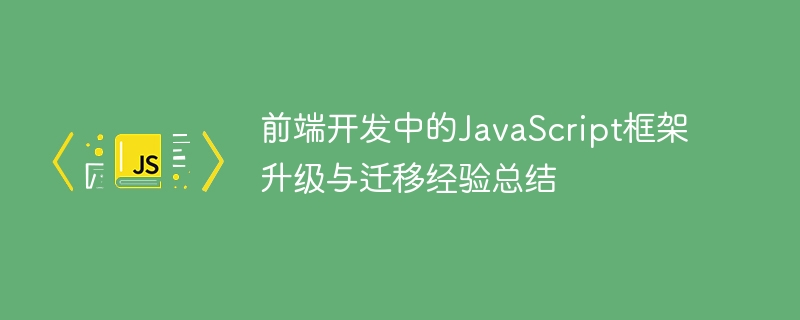

Experience summary of JavaScript framework upgrade and migration in front-end development
With the rapid development of the Internet, front-end development technology is also constantly progressing and evolving. JavaScript is one of the most important languages in front-end development. Various JavaScript frameworks are often used in different projects. As time goes by, many frameworks will have version upgrades or need to migrate to other frameworks. This article will summarize some experience in front-end development and discuss issues related to JavaScript framework upgrade and migration.
1. Understand the motivations for framework upgrade
Before proceeding with the framework upgrade, it is very important to understand the motivations for the framework upgrade. Possible motivations include but are not limited to: security issues, performance optimization, feature enhancements, and code maintenance costs. Based on the motivation for framework upgrade, we can better understand the benefits brought by the upgrade and provide a more reasonable solution for the upgrade.
2. Evaluate the feasibility of upgrading
Before deciding to upgrade a JavaScript framework, we need to evaluate the feasibility of the upgrade. Mainly including the following aspects:
1. Compatibility issues: Is the new version of the framework compatible with other codes in the current project? Are there any incompatibility issues? These questions need to be answered during the assessment process.
2. Functional differences: Does the new version of the framework provide new features or functional enhancements? Do these new features meet the needs of current projects? If the new functionality is valuable to the project, it makes more sense to upgrade the framework.
3. Learning cost: If you upgrade to a new version of the framework, you need to master the new API and usage. Therefore, we need to evaluate the time and cost required for team members to learn the new framework to ensure that the team has the ability to upgrade.
3. Develop an upgrade plan
After passing the assessment, we need to develop a detailed upgrade plan. Specifically, it includes the following steps:
1. Back up the current project: Before upgrading, be sure to back up the current project to prevent unpredictable problems.
2. Gradual upgrade: For large projects, it is recommended to upgrade gradually. You can upgrade some functional modules first, and then gradually upgrade other modules. This reduces risk during the upgrade process.
3. Testing and debugging: After the upgrade is completed, comprehensive testing and debugging must be performed. The testing process needs to cover various scenarios and user behaviors to ensure that the upgraded project runs stably.
4. Migrate to other frameworks
In addition to framework upgrades, sometimes we need to migrate projects to other frameworks. This could be because a new framework provides a better solution, or the team decides to change the technology stack, etc. Migrating to other frameworks has the following key steps:
1. Analyze the original project: Understand the framework structure, business logic and key functions of the original project to facilitate subsequent migration work.
2. Choose a new framework: Choose an appropriate new framework based on project needs. Take into account the characteristics, applicable scenarios and learning curve of the new framework.
3. Refactor the code: Refactor the original code according to the specifications and requirements of the new framework. This may involve rewriting business logic, adjusting project structure, modifying APIs, etc.
4. Testing and debugging: After the migration is completed, conduct comprehensive testing and debugging to ensure that the project runs normally under the new framework.
5. Summary and Suggestions
1. Before deciding to upgrade or migrate the JavaScript framework, be sure to evaluate the feasibility and develop a detailed upgrade plan.
2. During the upgrade or migration process, be sure to back up existing projects in case of emergency.
3. Gradual upgrade or migration can reduce risks and also facilitate project testing and debugging.
4. During the upgrade process, communicate with the community or framework officials in a timely manner to seek help and solve problems.
In short, JavaScript framework upgrade and migration are common requirements in front-end development. Through reasonable planning and implementation, the project can maintain the latest technical level and improve code quality and development efficiency. We hope that the experience described in this article can be applied in actual projects and help developers successfully complete framework upgrades and migrations.
The above is the detailed content of Summary of experience in JavaScript framework upgrade and migration in front-end development. For more information, please follow other related articles on the PHP Chinese website!
 attributeusage
attributeusage
 Website domain name valuation tool
Website domain name valuation tool
 What are the cloud servers?
What are the cloud servers?
 How to solve the problem of missing steam_api.dll
How to solve the problem of missing steam_api.dll
 Ethereum browser query digital currency
Ethereum browser query digital currency
 The main components that make up the CPU
The main components that make up the CPU
 What are the java file transfer methods?
What are the java file transfer methods?
 How to set the computer to automatically connect to WiFi
How to set the computer to automatically connect to WiFi
 Is Bitcoin trading allowed in China?
Is Bitcoin trading allowed in China?




